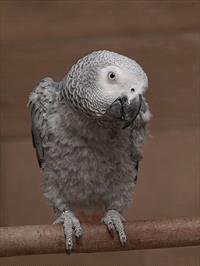African Grey Parrot

Feather picking is an all too common condition in pet bird population. Also known as feather destructive behavior or feather damaging behavior (FDB), it seems to be most common in African gray parrots, Quakers and various cockatoo species. Additionally, it is not uncommon among cockatiels, lovebirds and parrotlets. That being said, feather destructive behavior can occur in any bird species. This condition can often be frustrating to owners, and achieving a correct diagnosis and cure of the underlying condition can prove challenging for even the most experienced avian veterinarian. Many people think of FDB as strictly a cosmetic issue; this is often not entirely true and FDB may have a serious underlying medical cause.
Feather picking is more accurately defined as a symptom rather than a specific disease. There are many different possible causes. Broadly, these causes are categorized into two groups: medical and behavioral.
Medical Causes
Medical picking usually occurs because of an underlying disease that causes pain, irritation and or direct feather damage. Several examples of medically-induced FDB include: kidney and/or liver damage or failure; testicular or ovarian disease; musculoskeletal damage; gastrointestinal diseases or dysfunction; certain viral conditions; primary bacterial or fungal dermatitis; allergic skin disease; internal or external parasites; nutritional deficiencies. In order to diagnose these medical causes, a variety of diagnostic tests may be required in addition to a thorough history and physical examination.
Behavioral Causes
In simple terms, behavioral feather picking is often associated with boredom. In the wild, a bird's day is filled with activity; they spend the majority of their day foraging for fresh food and water and finding secure nesting or roosting sites. They also tend to spend a great deal of time socializing with other birds and preening themselves as well as other flock members. In the comforts of our homes and apartments, birds often need only walk a few inches along a perch to find large dishes full of plentiful food and water. They are often alone for many waking hours as the other members of their flock (humans in this case) leave the roost and go to work or school for the day. Typically most pet birds lack a companion for company and mutual preening, and this may predispose them to over grooming, which is often the first step on the road to feather-damaging behavior. Unfortunately, buying a companion bird may not cure a bird that is already picking, and in some cases may even worsen the situation due to incompatibility. In addition to boredom, other causes of feather picking include lack of exercise, inappropriate sleep patterns, and poorly directed reproductive behaviors.
Diagnostic Approach
It has always been my approach to first attempt to exclude medical causes of picking while always keeping in mind the behavioral components of the disease. This way, serious and potentially life-threatening diseases are not overlooked. Additionally, this approach may allow us to diagnose more minor conditions that, while not life threatening, can cause serious feather destructive behavior. Unfortunately, if left untreated for long periods of time, feather picking can become a habit. This may mean that when the instigating cause is discovered and cured, the feather damaging behavior may continue. In these instances a combined medical/behavioral approach is critical.
The assumption that all feather damaging is behavioral in origin is simplistic, incorrect and may have potentially serious ramifications for the patient. Only when we are confident that all underlying medical causes have been ruled out will we consider the condition to be primarily behavioral in nature.